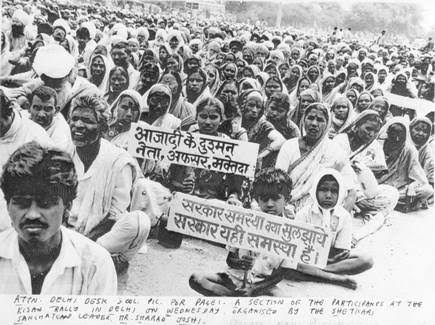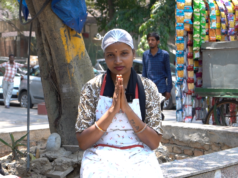The crisis facing India’s farmers has been as old as time itself. And throughout history, there have been numerous struggles and demands for reforms by Indian farmers against all dispensations. The demand for reforming the agricultural sector, giving access to open markets and de-regulating the economic freedom of farmers has been time and again raised in the past decades.
While the debate surrounding the current agri-reforms refuses to settle, it is pertinent to go back in time and to recall the rise of the Shetkari Sanghathana spearheaded by Sharad Anantrao Joshi. The Shetkari Sanghathana mobilised one of the largest farmer’s movements in the country and their demands were clear, a freer and liberal market to allay the plight of India’s farmers.
Produced below is the excerpt from a booklet titled ‘ Visionaries of a New Bharat – Shetkari Sanghathana’ which traces the evolution, the ideology and the vision of the Shetkari Sanghatana and elaborately lays down their demands with their rationale.
The Shetkari Sangathana (SS) in Maharashtra functioning since 1998 is a true representative of the present epoch of the farmer’s movement. The SS has been spearheading the developmental and ideological debate. The SS was kick-started in the late 1970s by Sharad Joshi. The SS is a non-political, non communal and non-pastoral union of peasants with a single point-programme – “Securing remunerative prices for the agricultural produce.” The single point may seem to be extremely simplistic, but, according to the thought of SS, it is the key to the economic development of India.
HISTORY OF FARMERS’ MOVEMENTS IN INDIA
Movements; agitations, uprisings and revolts by peasants are as old as history itself. The primary objective of the farmers’ uprising, agitations and conquests during the period of British Rule was to seek abolition of the Zamindari as against the Ryotwari (lease holder) system. In the long tradition of lndian history, the land in the village belonged to the village Panchayat. The division of agricultural labour continued from generation to generation between the cultivators and the artisans. The British brought in their own revenue system based on private ownership of land. Land was measured, numbered and allotted to prominent villagers who undertook to collect their revenue for the government or to those whose traditional role came closest to that of the cultivator/ accountant.
The British land tenure system had two effects. The invasion of the Indian domestic market by cheap products of the British industry, particularly textiles, crippled the village artisans and dried up the money inflows into the village economy. Under these circumstances, levy of land-taxes payable strictly in cash, drove even the relatively well-off farmers to borrow money from whoever happened to have some spare cash, howsoever paltry. In a very short time, indebtedness mounted and the mortgaged lands passed on to the moneylenders/zamindars. The resultant discontent was directed at the moneylender and revenue collecting landlords instead of the prime villains i.e. the Colonial State. The newly English educated and articulate nationalists movement blamed the state of Indian agriculture on the internal contradiction between the rich farmers and the small peasants. Till the independence in 1947, the poverty of the countryside was attributed to either the weaknesses of the cultivator or to the exploitation by the landlords and the moneylenders. The independence in 1947 brought in the abolition of both the revenue collector zamindars as also the moneylenders. The despised institutions were replaced by rigid credit and bureaucratic institutions that did not attenuate the level of exploitation but carried the agricultural surplus away from the countryside to the urban areas.
The independence and the partition marked the beginning of the years of food shortage and famines. The new national State started taking draconian measures calculated to take away food surplus from the villages to urban industrial areas. The commonly prevalent notion, at the time, was that the poverty of the farmers was due to low productivity, illiteracy, poorer health conditions and age-old social customs. The generally pervading spirit of nationalities did not permit the emergence of any farmers’ movement directed against the State. The Green Revolution of the 1960s changed all that. The agricultural productivity in most areas and crops multiplied manifolds. The farmers found, nevertheless, that their income was inversely proportional to the yields they obtained. India had a “Green Revolution” producing an abundance of crops but leaving the farmers indebted and poor.
This signaled the right moment for the emergence of a Nationalist farmers’ organization. The blame for the poverty could no more be put on the moneylenders or on the landlords. It was no more possible to blame the illiteracy, the indolence and wasteful social customs. The time survived for the emergence of the Shetkari Sanghatana.
To read the full text, click on this link.
IndianLiberals.in is an online library of all Indian liberal writings, lectures and other materials in English and other Indian regional languages. The material that has been collected so far contains liberal commentary dating from the early 19th century till the present. The portal helps preserve an often unknown but very rich Indian liberal tradition and explain the relevance of the writings in today’s context.
Read more: Do the farm bills benefit the farmers?
Post Disclaimer
The opinions expressed in this essay are those of the authors. They do not purport to reflect the opinions or views of CCS.






